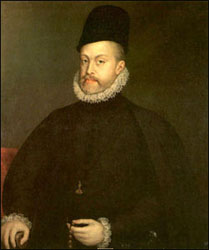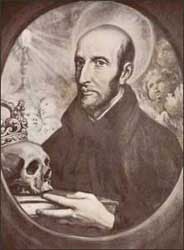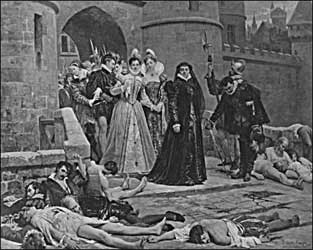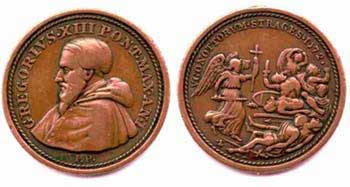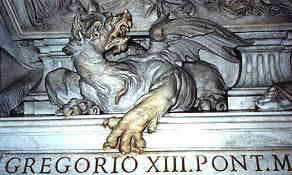|
August 24, 1572, was the date of the infamous St. Bartholomew's Day massacre in France. On that day, over 400 years ago, began one of the most horrifying holocausts in history. The glorious Reformation, begun in Germany on October 31, 1517, had spread to France—and was joyfully received. A great change had come over the people as industry and learning began to flourish, and so rapidly did the Truth spread that over a third of the French population embraced the Reformed Christian Faith. The Reformed Christians were intent on planting colonies in the New World and this was absolutely anathema to King Philip and the Spanish Inquisition. French Protestants were colonizing the New World!! The French Protestants ignored Pope Alexander's Bull against colonizing the New World, and as early as 1562, they tried to establish a colony in the area now known as South Carolina. Queen Elizabeth I encouraged this colonization as they were her co-religionists and she also bore the title:Queen of France. That colony, under Jean Ribault, was wiped out by brutal Spanish soldiers from their base in Augustine, Florida. The French Protestants were also sending help to their suffering brethren in Holland, who were defying overwhelming odds in order to throw off the Spanish yoke. Spain replaced France as the mainstay of the Vatican All during the Dark Ages, France was known as the eldest daughter and main pillar of the Papacy. King Pepin of the Franks (the father of Charlemagne) had given the Papal States to the Pope almost 1000 years earlier. Almost half of the real estate in the country was owned by the clergy. With the establishment of the Jesuit Order, the Papacy became a totally Spanish owned and controlled institution. Their 2 mains goals were: fight Protestant Christianity and keep all but Spanish away from the New World. The 3 masterminds behind the massacre!! The 3 masterminds behind the massacre of the French Protestants were: King Philip II, Pope Gregory XIII and Francis Borgia. Between this unholy trinity, it is hard to say which had the most zeal in shedding the blood of the saints.
The future Pope Gregory served as a legate to Philip II of Spain, being sent by Pope Pius V to investigate the Cardinal of Toledo. It was there that he formed a lasting and close relationship with the Spanish king, and the groundwork was laid for the extermination of the French Protestants. Don Francis Borgia was the great-grandson of Pope Alexander VI and co-founder of the Jesuits with Ignatius LIEola. On his mother's side he was descended from King Ferdinand of Aragon. King Philip II was the most bigoted fanatic that ever counted beads or crossed himself before a crucifix. It was said that the only time he ever laughed was when he heard the report of the infamous massacre:
The French Protestants were Les Misérables The work of extermination began suddenly in Paris with the ringing of church bells. Admiral Coligny—the Protestant leader—was stabbed and his body thrown out the window. French soldiers and the Roman Catholic clergy fell upon the unarmed people, and blood flowed like a river throughout the entire country. Men, women, and children fell in heaps before the mobs and the bloodthirsty troops. In one week, almost 100,000 Protestants perished. The rivers of France were so filled with corpses that for many months no fish were eaten. In the valley of the Loire, wolves came down from the hills to feel upon the decaying bodies of Frenchmen. The list of massacres was as endless as the list of the dead! Many were imprisoned—many sent as slaves to row the king's ships—and some were able to escape to other countries. . . . The best and brightest people fled to Germany, Switzerland, England, Ireland and eventually the United States, and brought their incomparable manufacturing skills with them. . . . France was ruined. . . . Wars, famine, disease and poverty finally led to the French Revolution—the guillotine—the Reign of Terror—the fall of the Roman Catholic monarchy—atheism—communism, etc., etc.
Pope Gregory was jubilant when news of the massacre reached the Vatican!! When news of the Massacre reached the Vatican, there was jubilation! Cannons roared—bells rung—and a special commemorative medal was struck—to honor the occasion! The Pope commissioned Italian artist Vasari to paint a mural of the massacre—which still hangs in the Vatican!!
This is the same Pope Gregory XIII who MASSACERED the calendar in 1582 by omitting 11 days from the month of October. At the present time, the Gregorian calendar is used in most countries of the world. Editor's Note The Huguenots won a short period of relief from persecution with the ascension of Henry IV to the throne. The Edict of Nantes gave full freedom to his Protestants subjects. The signing of this Edict inaugurated an era of peace and great prosperity for France. However, for granting his subjects liberty of conscience, the king was stabbed to death by a Jesuit named Ravaillac. This Edict of Toleration was revoked in 1685, and a new storm of persecution ensued. The exodus began again with over a million Huguenots fleeing France to avoid certain torture and death. The descendants of the survivors that reached the New World were determined that this tragedy should not occur here. Many of them were prominent in the founding of the country. They knew that an armed citizenry in France would have prevented this tragedy from ever happening—and as a result—they gave us the First and Second Amendments to the Constitution. They knew that freedom of religion and an armed citizenry go hand in hand: Amendment 1
Amendment 2
The French Protestants were called Huguenots: President George Washington had a Huguenot ancestor, as did at least 4 other Presidents: John Adams, John Quincy Adams, John Tyler, James Garfield. A Huguenot refugee named Apollos de Revoire settled in Boston, and had a son who signed his name Paul Revere....Three members of the Continental Congress—Alexander Hamilton, John Jay, and Elias Boudinot were Huguenots. Other great names include Francis Marrion, General George Patton, Clair Chennault, Admiral Dewey, Du Ponts, Henry Thoreau, Longfellow etc., etc. References Gray, Janet Glenn. The French Huguenots, Anatomy of Courage. Baker Book House, Grand Rapids, Michigan, 1981. Motley,
John Lothrop. The Rise of the Dutch Republic. (In 2 volumes).
George Allen & Unwin Ltd., London, 1889.
Nogueres, Henri. The Massacre of Saint Bartholomew. Allen & Unwin, London, 1962. Roche, Owen I.A. The Days of the Upright; the Story of the Huguenots. C.N. Potter, New York, 1962. Copyright © 2007 by Niall Kilkenny |
